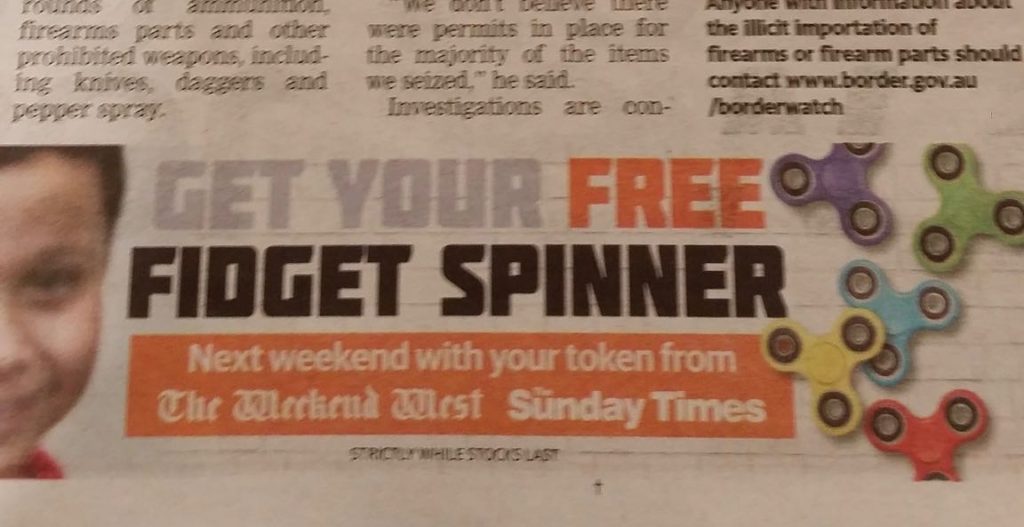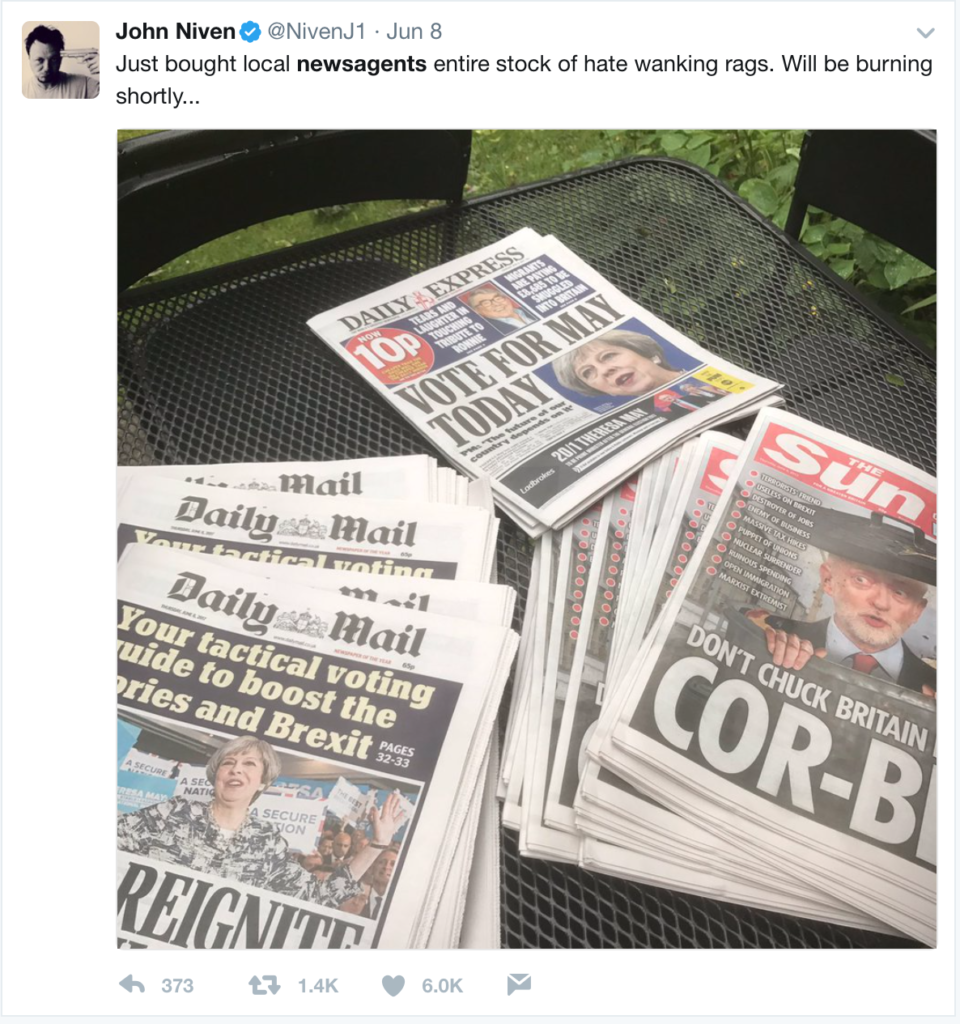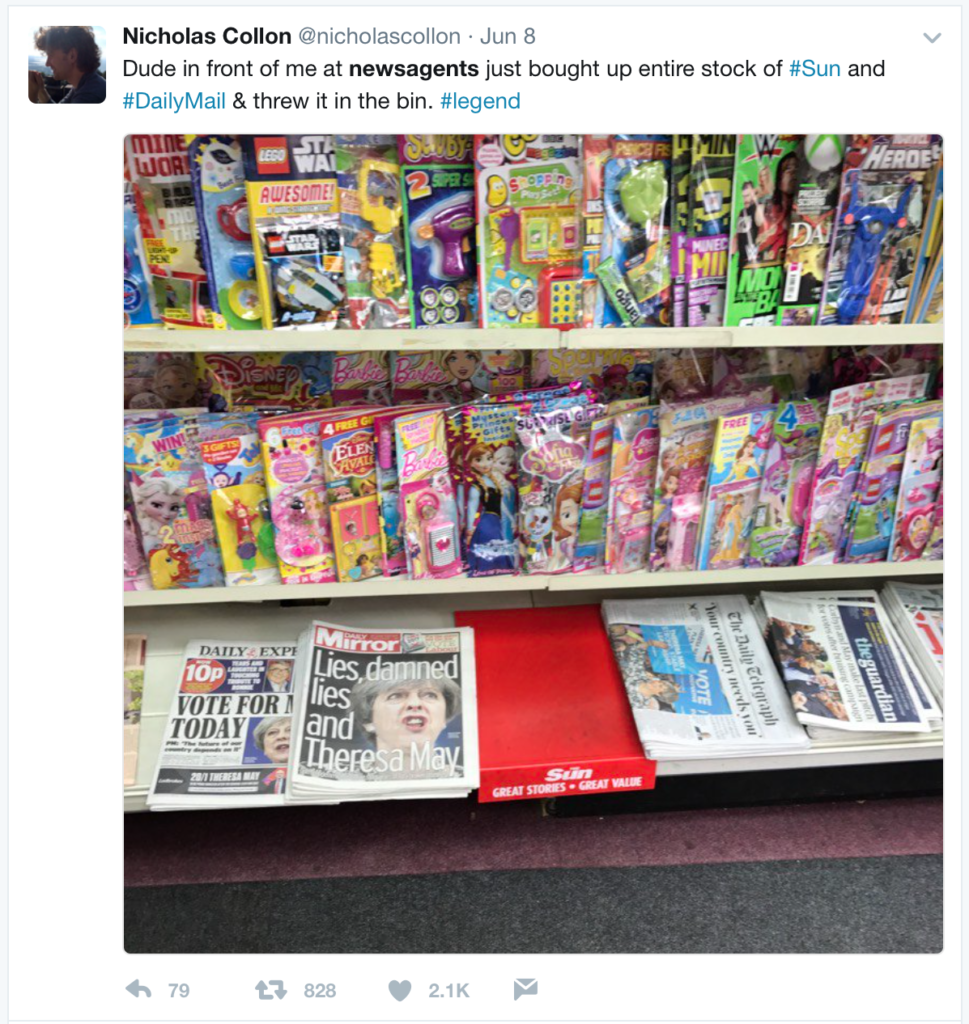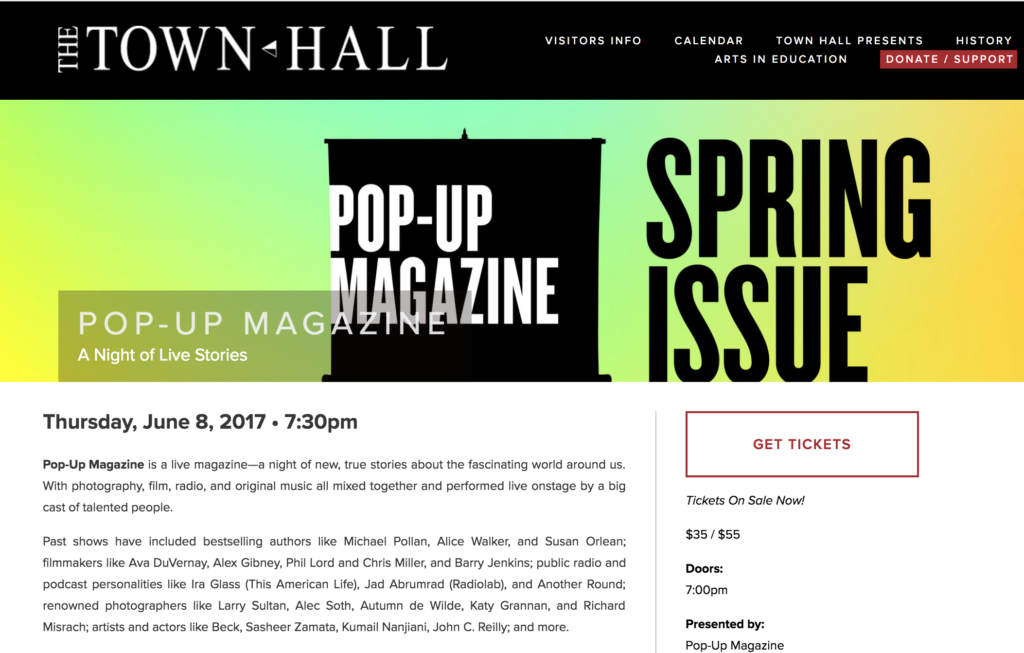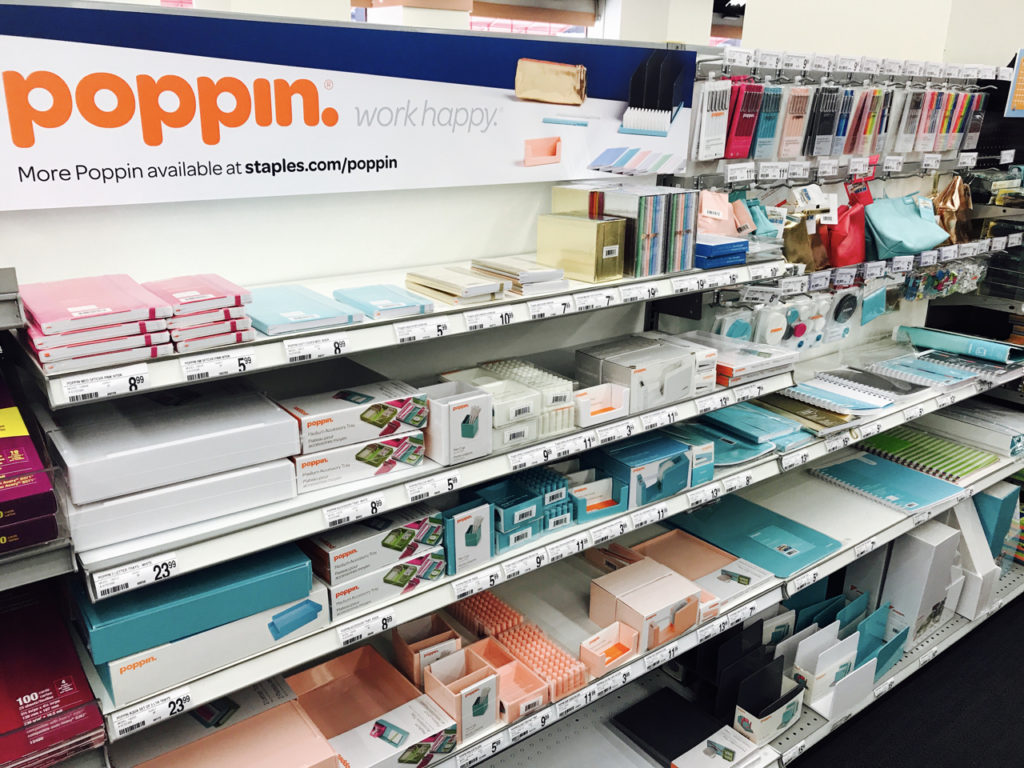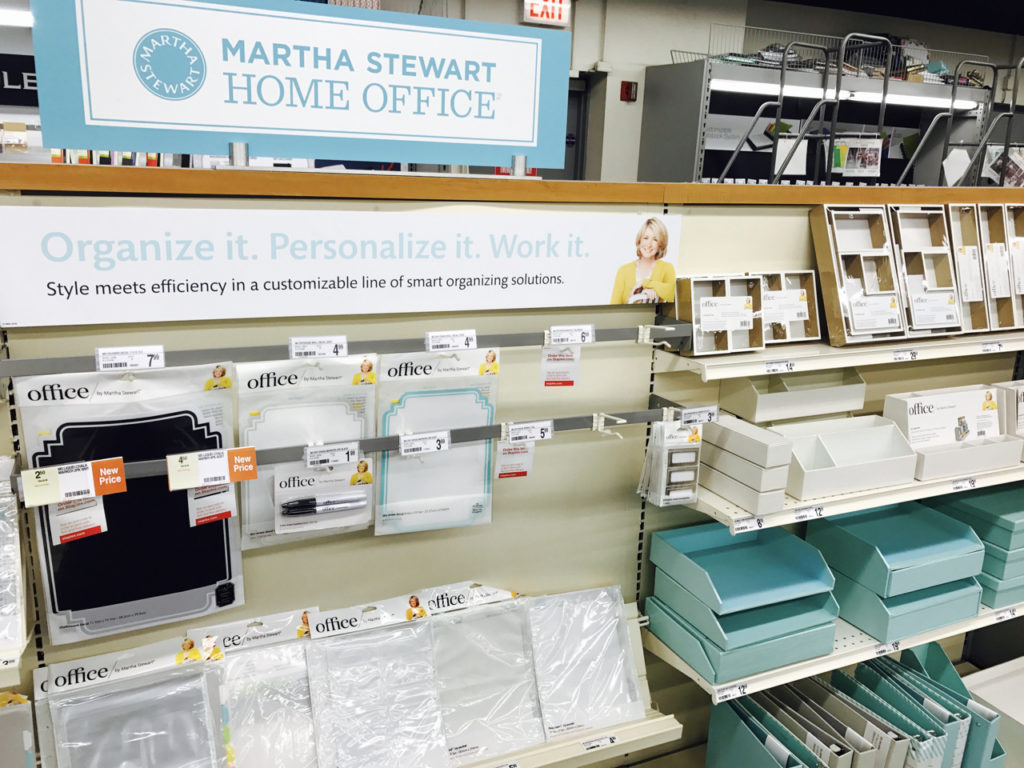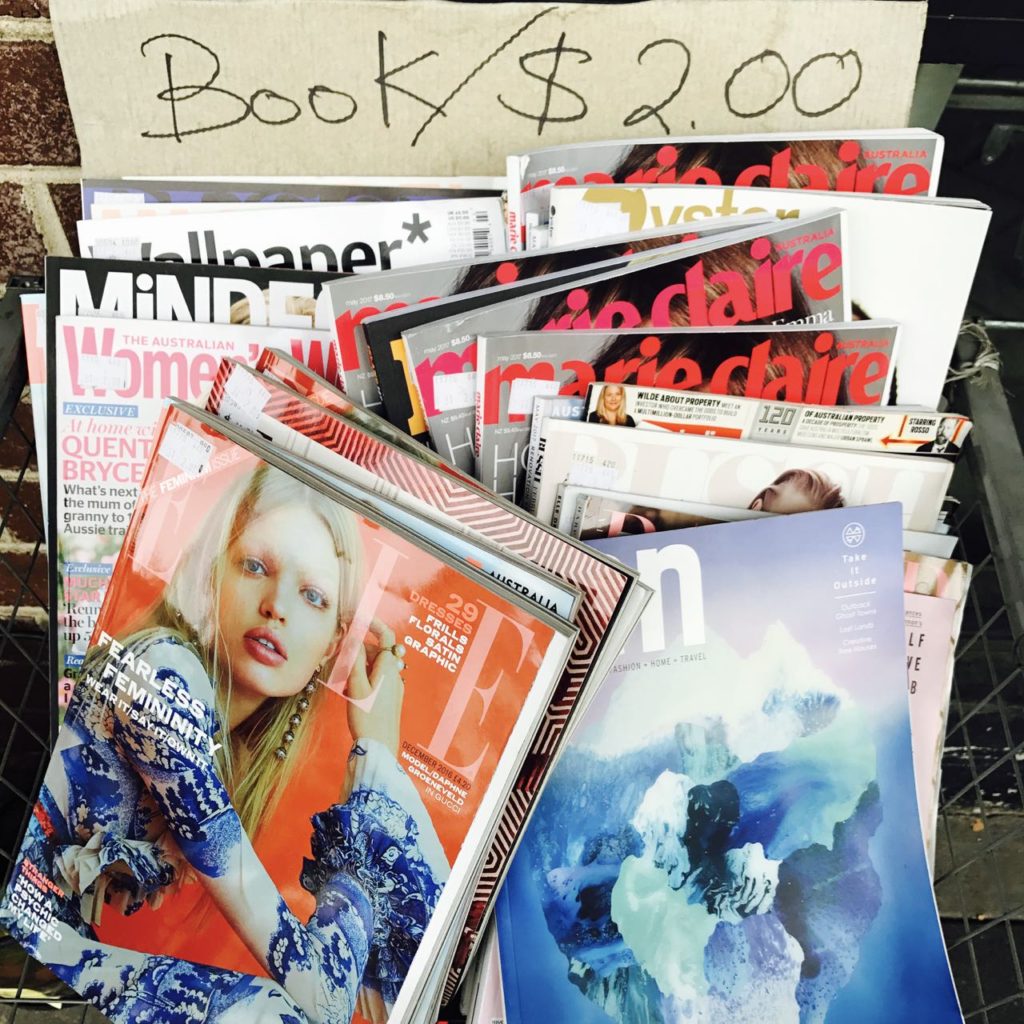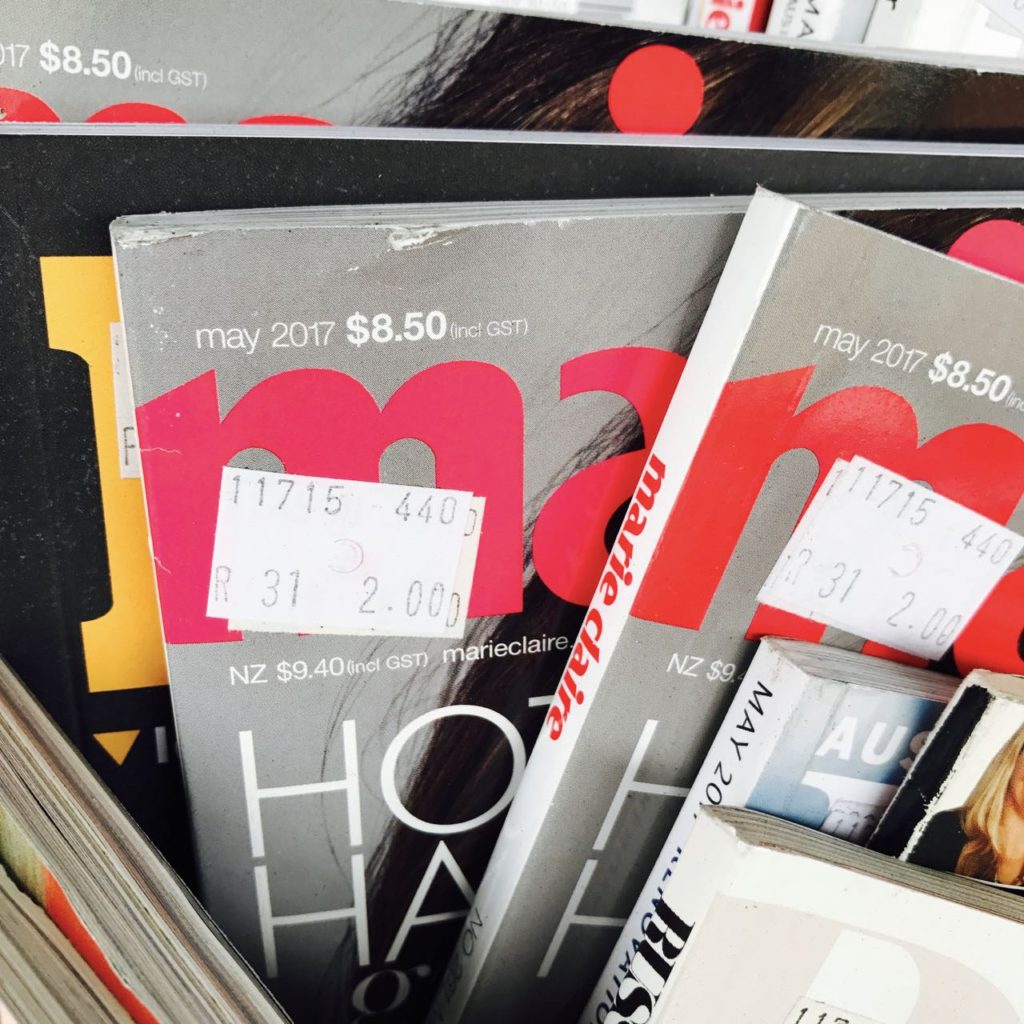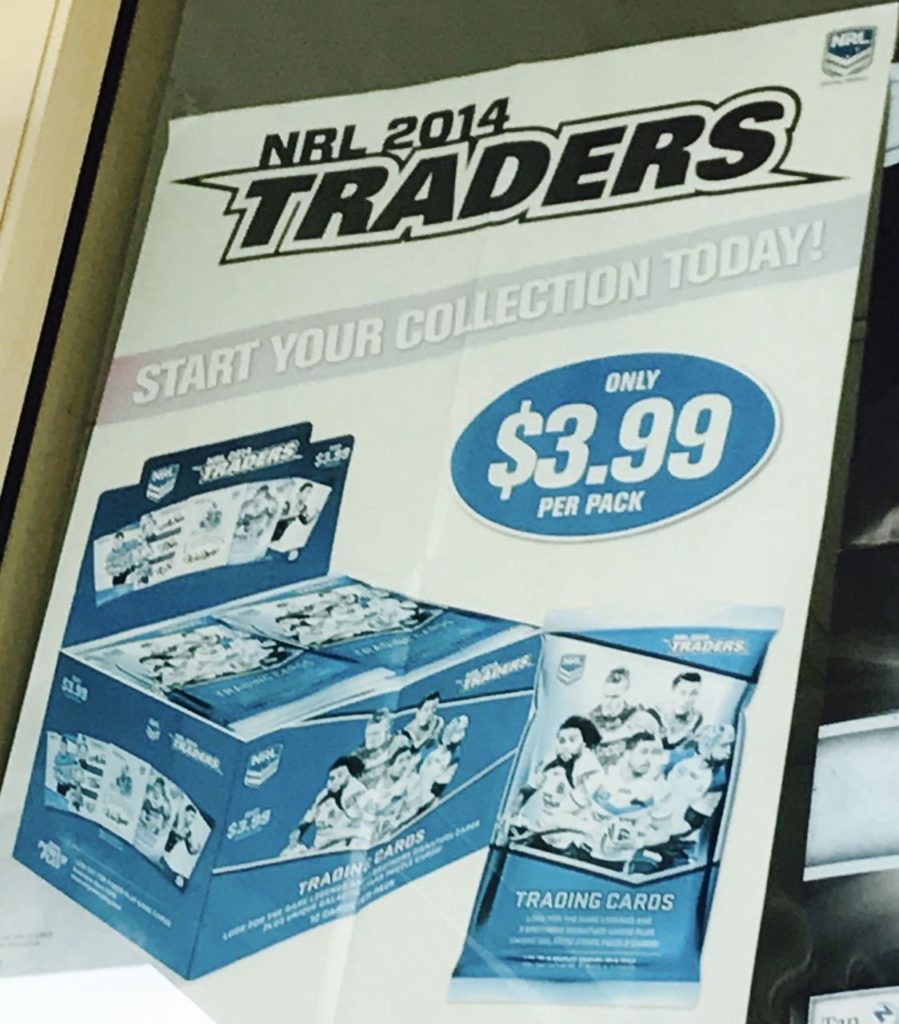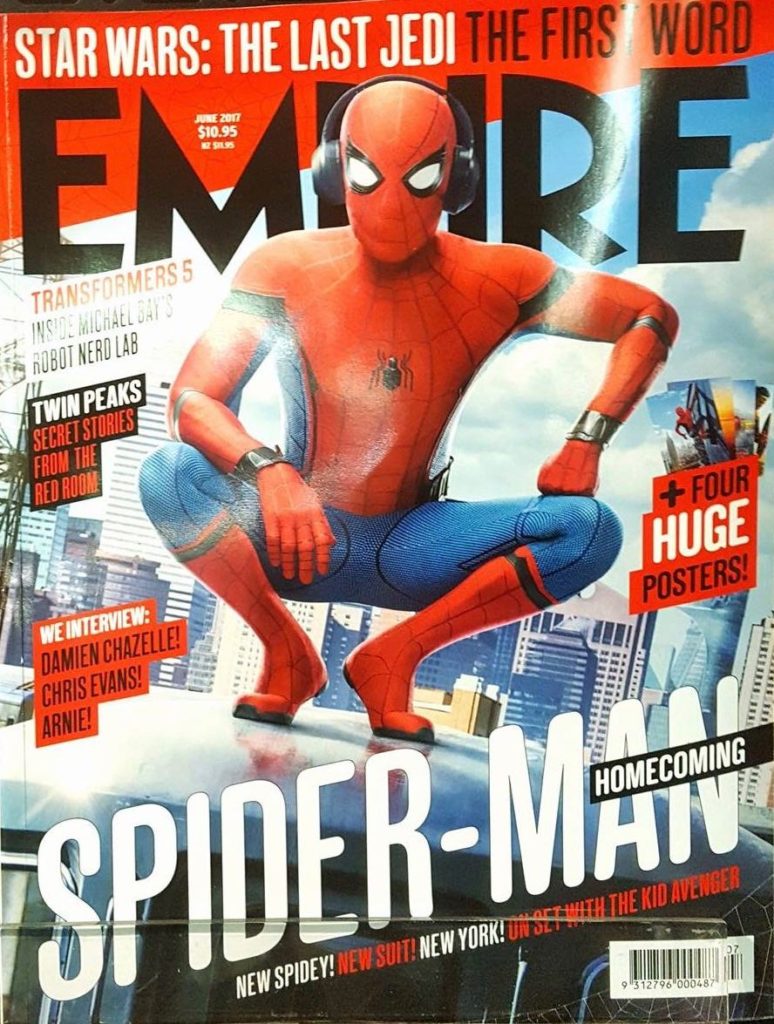Sunday newsagency management tip: look at the inventory performance gap
Business gurus often talk about the 80:20 rule, they find all sorts of ways to apply it. In newsagencies, we could apply it by saying that 80% of our product revenue comes from 20% of our products.
It is easy for newsagents to get this stat for their business. That’s my tip today, find out what your inventory gap is, the gap between the uber performing inventory items and the gap down to the rest, the products that don’t perform adequately for your business.
Free fidget spinner with WA Sunday paper
A few weeks ago I wrote about a free fidget spinner being offered by the Daily Mail in the UK. Now we have The Weekend West The Sunday Times offering a free fidget spinner. With fidget spinner sales in the toilet and some with stock left dumping them below cost, I wonder if this giveaway is too late.
Entertainment is vital in all retail experiences
What we know about social media today is that people engage more with content that is entertaining. This is also true for websites in plenty of retail segments. An entertaining site attracts people, holds them and drives engagement.
I say we know this because of data presented at just about every online retail conference I have attended in the last two years, most recently in Chicago this week.
There is no border between what people want and engage with online or in store. Entertainment is as important in store as it is online. The questions are: what is entertainment and how much is needed. These are vital questions because in our businesses, said raditional and transitioning, space, time and resources are limited. So, I suggest a simple approach, within our means.
Here are some examples of what I am talking about here.
- Buying. Buy products that lend themselves to in store demonstrations. Demonstrate them. Not all at once, but on rotation.
- Jigsaws. If you sell them, setup a table and encourage people to engage.
- Cards. Have a small table where people can sit and write cards. Scatter this with text suggestions.
- Craft. Let people do the craft works they want to do in your shop rather than at home.
- Show off. Have a place where people can show off how they use and interact with what you sell. This could be a place for photos or shelves on which people display art works or similar.
There are plenty more ideas. This list here is designed to get to you thinking of ideas appropriate to your specific business. If you are in a marketing group they should be a font of knowledge in this space for you.
Next time you see someone on social media on their phone, given that 80% and more of social media use in Australia is on phone and tables, watch the swipes. See how much time people give for what they see. Usually it is seconds. Yes, that is all yo have to grab the attention of people on their phone. It is similar in store.
Entertainment is key to making your store appealing for new traffic and appealing for existing traffic in store already. Do nothing and you will achieve barely average results.
A boost for newsagents in the UK election
If you check Twitter you will see an active campaign of people buying up anti Labour newspapers and binning them. Here is one example with plenty of likes and re-tweets:
Here is another that gained similar traction:
This is an interesting form of protest. I wonder if it will take off in Australia, particularly with the more biased mastheads.
Tatts fails to promote its retail network despite claims they do
While Tatts reps have been telling retailers that Tatts regularly promotes its retail network I am yet to see evidence of this in online ads by Tatts. These are ads placed by Tatts on news sites and social media sites pitching the latest jackpot or product offer.
All the online and social media ads I have seen the ad is about promoting immediate purchase through their website or app. I don’t recall seeing a pitch for the retail network or a link to a facility through which I can easily find my local retailer.
Now I need to note that Tatts is doing what I would do if I were them. For shareholders they need to be selfish and drive the best outcome for their business, and this is to drive online purchases.
The problem is, Tatts demands you spend a ton of cash promoting their brand. Part of their pitch is you do this for us and we do similar for you in our marketing. Maybe I have missed, it but I am not seeing Tatts promoting their retail network. Either they start promoting their retwith ail network or they stop saying the will.
The bigger challenge is how can Tatts partner with the retail network? 24/7? This is what Tatts should be working on. The retail network is a true asset to them. I’d go as far as saying the Australian retail network is the best retail lottery network in the world. Yet Tatts does not treat it well. Tatts actually promotes against the network, as I have written here.
Given the connection being demanded by Tatts between in store and online I think the most immediate connection Tatts could drive would be establishing a fund from their direct online sales, setting aside a portion of their own commission to be rebated to retailers based on the location of purchasers and their retail stores.
This single move would encourage retailers to work with Tatts as it monetises online engagement.
I appreciate this is not a new idea. I and others have pitched it before. The thing is, it is vital now given growth in online isales and the importance of newsagent in store branding to the broader Tatts message.
But the folks at Tatts don’t get this. They only see what works in the short term of their share price. My idea would benefit their share price but over the longer term.
The Tatts retail network is a asset of Tatts, if only they gave retail network the respect it deserves, if only their actions in terms of marketing reflected the words of their representatives when speaking to retailers.
A pop-up magazine, on stage
Check out this very cool looking pop-up magazine on stage at The Town Hall in New York.
Fidget spinners dead in retail
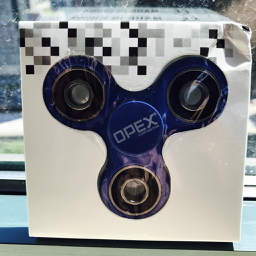 One way to tell is a retail product is dead is when you see it as a free gift at a business trade show. In Chicago today at the Internet Retail Conference & Exhibition six exhibiting companies were giving away fidget spinners. Most were giving them away without qualification, like they were offloading them.
One way to tell is a retail product is dead is when you see it as a free gift at a business trade show. In Chicago today at the Internet Retail Conference & Exhibition six exhibiting companies were giving away fidget spinners. Most were giving them away without qualification, like they were offloading them.
What next for Officeworks?
With the sale of Officeworks off the table I expect Wesfarmers will increase engagement with the group, to lift performance. This could mean further diversification by the group, further into areas impacting us. That is what I would do if I were them.
We already see Officeworks playing well in the social stationery space as well as some gifting, games and puzzles. Plus, they are very strong in calendars.
The extent of change already seen at Officeworks over the last two years is instructive to newsagents contemplating change. This is a reason I visit Officeworks stores regularly. There is plenty to learn – not necessarily to copy but certainly to learn.
While city newsagency businesses are most obviously impacted the most by Officeworks, regional stores are impacted too because of their strong online presence.
When able, visit Officeworks and take a close look at what they are doing. Be sure to check back regularly as the change between visits is well worth seeing. I certainly find it worthwhile.
While we are talking about Officeworks, look online at what Staples is offering. Their penetration is increasing in Australia from what I understand and it is happening mainly under the radar – because you don’t see the business they are doing.
Staples is ahead of Officeworks when it comes to funky and on-trend products. Here are two examples they have in-store in the US right now, both compelling offers, both expanding the reach of what we consider to be stationery.
Click and collect helps engaged retailers find new shoppers
newsXpress has been offering click and collect for its various member store-connected online websites for months. It is a ripper of a success, both in terms of sales and attracting new shopper traffic.
Click and collect is where people shop online and visit a physical store to pick up the goods purchased. It is a major focus of big business retailers like David Jones, Myer, Officeworks, Coles and others. Offering it shows online shoppers how current you are in your online approach. It builds trust.
Customers like that they can shop online at any time, pay online, and be certain that what they purchased is set aside for them to collect at any time.
It is shop online at any time that matters in that the majority of transactions are done outside usual shopping hours. This gives click and collect businesses an advantage – they can win the sale and bank the revenue while their nearby competitors are closed.
Another benefit of click and collect is that it introduces new shoppers to a business. Two thirds of click and collect shoppers surveyed visit the shop from where they collected the goods for the first time. Half purchased other items while in the store. Close to half came back for more purchases, having discovered what the store sells.
Around a quarter of click and collect shoppers use interest-free online LayBy … meaning they buy now, pay later and get the goods right away. The retailer is paid right away less a tiny processing fee that is not much more than the usual credit card fee.
Click and collect is not a massive game changer. Rather, it is a small step in a series of steps that make up a successful comprehensive online strategy.
A comprehensive online strategy is key to competing with other online businesses as well as with other high street businesses.
The way newsXpress leverages click and collect is through offering access to absolutely current stock on hand data for sought after brands. Having this, updated every 5 minutes 24/7 is what shoppers want when shopping online. It is hard to achieve – this is a reason many small and independent retailers and retail groups have not done it.
Online is big and growing. You only have to look at data from any of the online giants to understand this.
Today’s newsagency, not!
Here are three photos from the outside of a newsagency I saw on the weekend. Magazine returns for $2.00. Old-school magazine stickers that make newsagents look bad. A NRL poster from 2014. Shocking.
What surprises me is the business has Tatts and it looks as bad as these photos. How the Tatts reps could allow the business to trade, as they have done for years, while the busily breach professional looking businesses for minor infractions is a joke.
This newsagency is an embarrassment to any retail business that trades under the Newsagency shingle. It would be good for there to be a way to stop them using the shingle.
Stunning and timely magazine covers help us reach beyond traditional
Here are two magazine covers that we can use on social media and elsewhere to pitch our businesses outside what is traditional for newsagencies. We can also use them in-store, outside the magazine department, placed with products that appeal to the same shopper. That is what we are doing with Frankie and Empire.
The Gotch no physical returns project can help improve magazine engagement
 The no physical returns project commenced early this year by Gotch is proving to be successful among plenty of the newsagents who have been carefully selected by Gotch to participate.
The no physical returns project commenced early this year by Gotch is proving to be successful among plenty of the newsagents who have been carefully selected by Gotch to participate.
Once newsagents have enjoyed no physical returns, they will work hard to ensure they meet the criteria for this to continue.
The project also focusses attention at Gotch and publisher businesses to supply closer to anticipates sales as there will be no stock for them to repurpose.
Kudos to everyone involved in getting the project this far.
I urge newsagents not involved in this project so far to ensure they manage their data well, so they can be considered. Gotch looks at your compliance as measured by XchangeIT. To measure well you need to accurately receive electronic invoices, scan all returns, provide sales data electronically and not purchase top-up stock elsewhere if you are short supplied.
The hurdle is relatively low. Every newsagent should be able to meet the requirements.
A by-product of meeting the requirements is knowing more about magazines and having the ability to leverage this knowledge to save time managing magazines and, yes, improving sales of magazines.
While there is plenty more to do on the magazine front, this project is some good news for newsagents and their engagement with magazines.
In writing about this I understand I am opening the topic up for criticism by some who are not part of the trial. If that is you I encourage you to drive compliance in your business. Your software company can look at your data and provide advice and help. Others reading this will say why bother doing anything for magazines? To them I say many newsagents do care. Let them care, let them leverage what they see as an important product category. Sure have the blues yourself, and keep them to yourself. This post is good news.
Sunday newsagency management tip: how to deal with the emotional impact of employee theft
Beyond the financial cost and regardless of the size of the theft, employee theft in a retail business can come at a huge cost to the business, those who work in it and the owners.
The impact can be felt for years after employee theft is discovered.
I have been involved in supporting plenty of retailers dealing with employee theft in their businesses.
Often, the person caught stealing from a retail business is one of the most trusted employees. This is where the high emotional cost kicks in. It is not uncommon for them to be a long term employee who has the trust and respect of the business owners. Often, it has been a relative of the owner or at least someone treated as a relative or a member of the family.
I see the impact of the theft flowing in waves:
- Typically, the retail business owners blame themselves for the theft or at the very least for not having discovered it sooner.
- What follows is the extraordinary feeling of a breach of trust and violation. This can lead to a feeling of overwhelming illness. In some cases, one or more of the business owners have withdrawn from the business – such is the personal hurt and betrayal they feel.
- Devastation often kicks in with the owners losing focus on the business, unable to deal with the issues of today.
- Depending on the extent of the theft, depression can follow which requires some form of intervention to resolve.
The personal impact on the outlook and confidence of the business owner can be devastating. Unless they are able to accept what has happened and genuinely move on, they could find themselves wallowing in anger, inaction or even depression for long after the crime has bene discovered.
The key, from our personal experience, is to accept what has happened, make a decision on how to deal with it and move on… never looking back.
Discovering an employee theft problem is an excellent first step. The alternative is that it continues unabated. Discovery stops the theft and that is a great first step. It is important to acknowledge the good news of the discovery regardless of the quantum of theft discovered.
Deciding an action plan is the ideal step two. Deciding whether to report the crime or agree on an immediate financial settlement with the employee who committed the crime is the best next step. Only the retail business owner can decide whether reporting the crime is worth it or not. Sometimes, being paid a reasonable sum by the employee is better for the business and moving on than a protracted police investigation.
Talk with the team. Listen. Console. This is a time for grieving about what happened. Either gather as a group or one on one. Ensure that everyone has an opportunity to air their feelings. Business partners especially should take time to do this and explore how they feel. Do not let this process go on too long. Ensure that everyone understands that this is the time of grieving and that when it ends, it ends so that the business and those involved can move on.
Focusing on the business is the fourth important step. Once the employee theft is caught, the action plan re police versus reimbursement resolved, the next focus has to be the business. Difficult as this is, it is important to move forward rather than to stand still and wonder what might have been or worry about the betrayal one feels. Look at business practices and modify these so that theft is harder to perpetrate, implement processes which disrupt the business and make theft easier to detect.
There are excellent government and community resources which can help. Engage and use these resources and benefit from the insights of others.
How a retail business comes out of discovering employee theft is up to the leaders of the business themselves. They set the mood for the team. It is important to reach a point of moving on and not looking back as soon as possible – for the sake of the business, its employees and its customers.
Sunday newsagency marketing tip: place Better Homes and Gardens with newspapers
 Years ago I started placing Better Homes and Gardens magazine between the Herald Sun and The Age. I still do it today – because it achieves incremental sales of this broad appeal top selling magazine. I do it Thursday through Sunday. Try it. It is a no-cost marketing tip that is sure to achieve incremental sales.
Years ago I started placing Better Homes and Gardens magazine between the Herald Sun and The Age. I still do it today – because it achieves incremental sales of this broad appeal top selling magazine. I do it Thursday through Sunday. Try it. It is a no-cost marketing tip that is sure to achieve incremental sales.
Are Tatts and Lottoland in bidding war for Jumbo Interactive?
An article at ValueWalk seems to think so:
Over the last couple of weeks, a bidding war has emerged.
- On April 24, Lottoland disclosed the acquisition of 3.1 million shares (7%) in the open market.
- On May 12, Jumbo issued 6.6 million shares (15%) and another 3.5 million share options (subject to shareholder approval) to Tatts at a significant discount to the market price that day (AUD 2.37 vs 2.75). In return, Jumbo renewed all reseller agreements with Tatts for five years and, in addition to the cash raised, gained access to a new product (“Set for Life Game”).
I don’t have a problem with Jumbo forming a stronger alliance with Tatts, however Jumbo should at least agree on a price that’s fair to shareholders. Jumbo accounts for 10% of Tatts’ total lottery revenue and is in a strong position to further grow market share given its technical and marketing know-how. In addition, the ongoing Tatts/Tattersalls merger could further help expand and diversify Jumbo’s product portfolio going forward.
Free POS software / e-commerce workshops in regional NSW and QLD
Retail is changing at a rapid rate. Changes in-store and online are making 2017 an important year.
I have seen changes first-hand at international retail conferences this year. I play with changes myself in my own shops where I use my POS software and my website technology to find new customers and drive a higher average spend.
I am hosting FREE workshops in regional NSW and QLD to help retailers equip their retail business to confront the changes in retail, transact online and compete with big businesses, including Amazon.
Here are the dates for the workshops. Click on the city name to book your place:
- Coffs Harbour. June 19. 10am. Novotel.
- Tamworth. June 20. 10am. Leagues Club.
- Newcastle. June 21. 10am. Mercure.
- Dubbo. June 22. 10am. Quest.
- Wagga Wagga. June 23. 10am. International Hotel.
- Cairns. June 26. 2pm. Novotel.
- Townsville. June 27. 10am. Mercure.
- Mackay. June 28. 10am. Mackay Grande Suites.
- Rockhampton. June 29. 10am. Quest.
- Gold Coast. July 5. 2pm. Sofitel
I will share insights on how small business retailers around the world are using website connected POS software to win online sales.
I will explain how to get to the top of Google search results and demonstrate the connection between social media posts (Facebook, Twitter etc) in-store sales and online sales.
The goal is to share practical information to help you better plan for the future of your regional retail business.
Anyone is welcome including people on whom you rely for advice, such as accountants and mentors.
There will be plenty of time for questions on any topic connected with retail.
Background briefing: crunch time for newspapers
Click here to listen to a new ABC radio documentary on the challenges facing Australian newspapers. The good news is the new media outlets emerging, being created by journalists made redundant. It’s well worth a listen.
Good result for magazines in May in the newsagency
Comparing the performance of the newsagency for May 2017 with May 2016 shows a good result for magazines. While overall unit sales declined 5%, weeklies only declined 1% – and they account for 44.35% of all our magazine sales.
I say he 5% decline is good as this is happening in a period when many are experiencing double digit and more decline in unit sales.
In our situation the categories of concern are sports, computers and music. For us, these categories are in dangerous decline.
Craft & hobbies and home & lifestyle are the two terrific growth categories with each achieving 20% year on year growth in unit sales. Both are high value categories in that they are more likely to drive extra value purchases in the business.
I am feeling good about magazine sales in May. They have contributed well to the business and the declines of 2016 have significantly slowed for us.
Sunday Herald Sun QBD Books offer confuses shoppers
 We have customers frustrated and confused by a Sunday Herald Sun QBD Books promotion. Given the way promotions in the newspaper run, they expect newsagencies to be the redemption point. Some are frustrated when told this, others are angry. There is clearly an expectation they redeem from us.
We have customers frustrated and confused by a Sunday Herald Sun QBD Books promotion. Given the way promotions in the newspaper run, they expect newsagencies to be the redemption point. Some are frustrated when told this, others are angry. There is clearly an expectation they redeem from us.
While the fine print and website make the situation clear…
…people still expect newsagents to have the free books. Plenty of people based on our own experience.
All it take is one agitated person to complain loudly in a shop full of people to turn some away and cost the business potential revenue.
I’d like to see the coupon to be redesigned to be clearer, with a headline: REDEEM FROM QBD BOOKS.
From a marketing perspective, the promotion is clunky. Buy a product from one shop and take it to another shop to get the gift. While I understand it is traffic QBD wants, the execution is clunky and generating friction for newsagents.
Relieving newsagents
This post is an opportunity for people to comment. If you are a relieving newsagent, feel free to share your details. If you are looking for a relieving newsagent, feel free to share your details.
The ripple effect of a good Facebook post
We have sold four units of a $75.00 item in the last week. It was not until the fourth sale that we realised the connection of the sales.
The first purchase was a result of a Facebook post we published and boosted for $3.00. That purchase was the first time the shopper had been in our store. They visited having asked us a couple of questions about the product at around 9:30pm at night, on Facebook.
A friend of the first shopper was in two days later and purchased the same item.
A friend of the friend was in the next day, purchasing the same item.
The first shopper was back yesterday, purchasing the same item to post to a family member. That is when we learned of the ripple effect value of the boosted Facebook post.
Two factors played in our favour – the boosted post and being accessible to answer a customer query at 9:30pm. Combined, those two things won us $300.00 in sales and a customer who will return.
Being online takes a range of forms. It does not necessarily mean having a website. However, it does mean being accessible when people want to browse and shop.
The data I see, from a range of retail business websites in different retail channels, show that after 8pm is the busiest online sales time in Australia, through until midnight. If you have any online presence, it is vital you are accessible during this time.
Welcome to the new retail paradigm.

